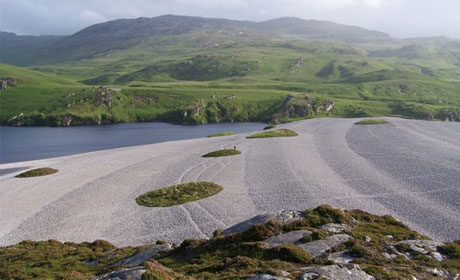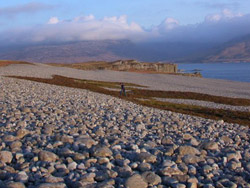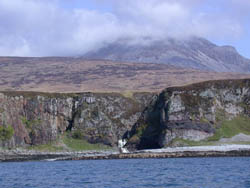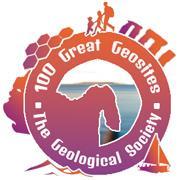Raised beach at Loch Tarbert
Jura, Inner Hebrides, Scotland

Nominated by: Selection Committee
This site is internationally important for its superb examples of raised shore platforms and raised beaches. These landforms reflect changes in relative sea level associated with the growth and decay of ice sheets during the Quaternary Ice Age.
Ice Age Land and Sea Level Changes
 During glacial periods, sea level fell as expanding ice sheets locked up the world’s fresh waters, and rose again during interglacials when the glaciers melted and released their water back into the sea. The level of the land has also varied, the crust sinking under the weight of the ice sheets and slowly rising up again when they melted. Because the crust was pushed down further where the ice was thicker, areas near the centre of the ice sheet (roughly centred on Rannoch Moor) have had further to rebound and are still continuing to rise today.
During glacial periods, sea level fell as expanding ice sheets locked up the world’s fresh waters, and rose again during interglacials when the glaciers melted and released their water back into the sea. The level of the land has also varied, the crust sinking under the weight of the ice sheets and slowly rising up again when they melted. Because the crust was pushed down further where the ice was thicker, areas near the centre of the ice sheet (roughly centred on Rannoch Moor) have had further to rebound and are still continuing to rise today.
In contrast, in those areas near the periphery of the ice sheet (e.g. the Northern and Western Isles), most of the uplift was completed a few thousand years ago, so that relative sea level has been rising there. Relative sea level attained its highest level around 15,000 years ago as the Scottish ice sheet was melting rapidly and the land was still pushed down; a later, lower peak occurred around 7000 years ago, following the final melting of the North American and Scandinavian ice sheets.
Shore Platforms
 Along with northern Islay, the West Coast of Jura contains some of the finest examples of raised shore platforms and unvegetated raised shingle ridges in western Europe. Three shore platforms have been identified: the High, Main and Low Rock Platforms.
Along with northern Islay, the West Coast of Jura contains some of the finest examples of raised shore platforms and unvegetated raised shingle ridges in western Europe. Three shore platforms have been identified: the High, Main and Low Rock Platforms.
The High Rock Platform is well developed north of Loch Tarbert where its inner edge lies between 32-34m OD. It probably formed by a combination of marine and cold-climate shore processes during successive glacial periods at times when the margin of the Scottish ice sheet lay to the east of Jura.
The seaward edge of the High Rock Platform is cut by the backing cliff (10-15m high) of the Main Rock Platform, which forms a prominent feature along much of the coast. This platform, between 3-5m OD, is considered to have been cut (or retrimmed) also by a combination of marine and cold-climate shore processes (intense frost weathering and removal of debris by sea-ice) during the Loch Lomond Stadial 12,900 to 11,500 years ago.
The Low Rock Platform occurs in the intertidal area, and in places is ice-moulded. The time of formation of the High and Low rock platforms is uncertain. They are overlain by till, or are ice-moulded, indicating that they pre-date the last (Late Devensian) ice sheet glaciation.
Raised Beaches & Shingle Ridges
Raised beaches are superbly developed along the coast. They occur as terraces and extensive ‘staircases’ of unvegetated shingle ridges. The higher terraces extend up to about 40m OD and rest on the surface of the High Rock Platform. They were formed at a time of high relative sea level as the last ice sheet was melting around 15,000 years ago.
The altitude of these beaches noticeably increases northwards, indicating the increased isostatic rebound in this direction, towards the area of thickest ice cover. The lower ‘staircases’ of shingle ridges record the relative fall of sea level as the land rebounded.
Suites of postglacial shingle ridges cover the surface of the Main Rock Platform. These have formed in the last 7000 years or so as relative sea level dropped following the culmination of the Main Postglacial Transgression.
Text: ScottishGeology.com
Related Links
Images (top to bottom):
- Raised Beach at Loch Tarbert © Chris Lindsay, Source Geograph.org.uk, Creative Commons Attribution-ShareAlike 2.0 license
- Raised beach East of Ruantallain © Tony Page, Source Geograph.org.uk, Creative Commons Attribution-ShareAlike 2.0 license
- Shore platform from the sea © Tony Page, Source Geograph.org.uk, Creative Commons Attribution-ShareAlike 2.0 license

October 13 - 21
Theme: 'Earth Science in our lives'
